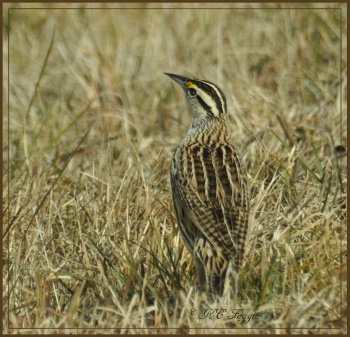- Sturnella magna
Identification
20–24 cm (7¾-9½ in). A medium-sized icterid.
Adults
- Yellow underparts
- Black "V" on breast
- White flanks with black streaks
- Upperparts are mainly brown with black streaks
- Long pointed bill
- Head is striped with light brown and black
Similar Species
Very similar in appearance to the Western Meadowlark, but the Eastern usually has white malar instead of yellow and show more white in the tail. They are best distinguished by song. Chihuahuan Meadowlark is paler with even more white in wings and tail.
Distribution

Photo © by Stanley Jones
Belton, Stillhouse Hollow Lake, Rivers Bend Park, Bell County, Texas, USA, January 2018
Across eastern North America to South America. The ranges of the Eastern and Western Meadowlarks overlap across the center of the continent. There is no overlap in breeding range between Eastern and Chihuahuan Meadowlark. These birds are permanent residents throughout much of their range. Northern birds migrate southwards in winter.
Taxonomy
The pale southwestern desert form, S. [m.] lilianae, was split in 2022 as Chihuahuan Meadowlark.
Subspecies
This is a polytypic species consisting of 15 subspecies[1]
- S. m. hippocrepis: Cuba and Isle of Pines
- S. m. magna: Southern Ontario east to Quebec and south to northern Texas and north-eastern Georgia
- S. m. argutula: South-east Kansas and Oklahoma to eastern US (Carolinas to Florida)
- S. m. hoopesi: South Texas (Eagle Pass) to north Coahuila, Nuevo Leon and northern Tamaulipas (east of Llano Estacado in Texas)
- S. m. saundersi: South Mexico (Oaxaca)
- S. m. alticola: Highlands of southern Mexico (Guerrero, southern Puebla, Veracruz) to Costa Rica
- S. m. mexicana: Caribbean slope of south-eastern Mexico (Veracruz and Tabasco to Chiapas)
- S. m. griscomi: South-eastern Mexico (arid coastal northern Yucatan Peninsula)
- S. m. inexpectata: Pine savanna of Belize, Pet‚n of Guatemala, Honduras, Nicaragua
- S. m. subulata: Pacific slope of Panama
- S. m. meridionalis: Eastern Andes of Colombia to Andes of north-western Venezuela
- S. m. paralios: Northern Colombia and savannas of western Venezuela
- S. m. monticola: Tepuis of southern Venezuela (Mount Roraima)
- S. m. praticola: Llanos of eastern Colombia to southern Venezuela and northern Guyana
- S. m. quinta: Suriname and north-eastern Amazonian Brazil
Habitat
Their breeding habitat is grasslands and prairie, also pastures and hay fields.
Behaviour
These birds forage on the ground or in low vegetation, sometimes probing with its bill.
Diet
They mainly eat insects, but also seeds and berries. In winter, they often feed in flocks.
Breeding
The nest is on the ground, covered with a roof woven from grasses. There may be more than one nesting female in a male's territory.
Vocalisations
Examples of Eastern Meadowlark giving the song of Western Meadowlark are rare
References
- Clements, J. F., T. S. Schulenberg, M. J. Iliff, T. A. Fredericks, J. A. Gerbracht, D. Lepage, S. M. Billerman, B. L. Sullivan, and C. L. Wood. 2022. The eBird/Clements checklist of Birds of the World: v2022. Downloaded from https://www.birds.cornell.edu/clementschecklist/download/
- Gill, F, D Donsker, and P Rasmussen (Eds). 2022. IOC World Bird List (v 12.2) DRAFT. Doi 10.14344/IOC.ML.12.2. http://www.worldbirdnames.org/
- Birdforum thread discussing new splits in HBW16
- Proposals for taxonomic change to the NACC 2022-C; C2 was the proposal leading to split of Chihuahuan Meadowlark
- Birds of North America Online
Recommended Citation
- BirdForum Opus contributors. (2024) Eastern Meadowlark. In: BirdForum, the forum for wild birds and birding. Retrieved 27 July 2024 from https://www.birdforum.net/opus/Eastern_Meadowlark
External Links
Search the Gallery using the scientific name:
Search the Gallery using the common name:
GSearch checked for 2020 platform.







